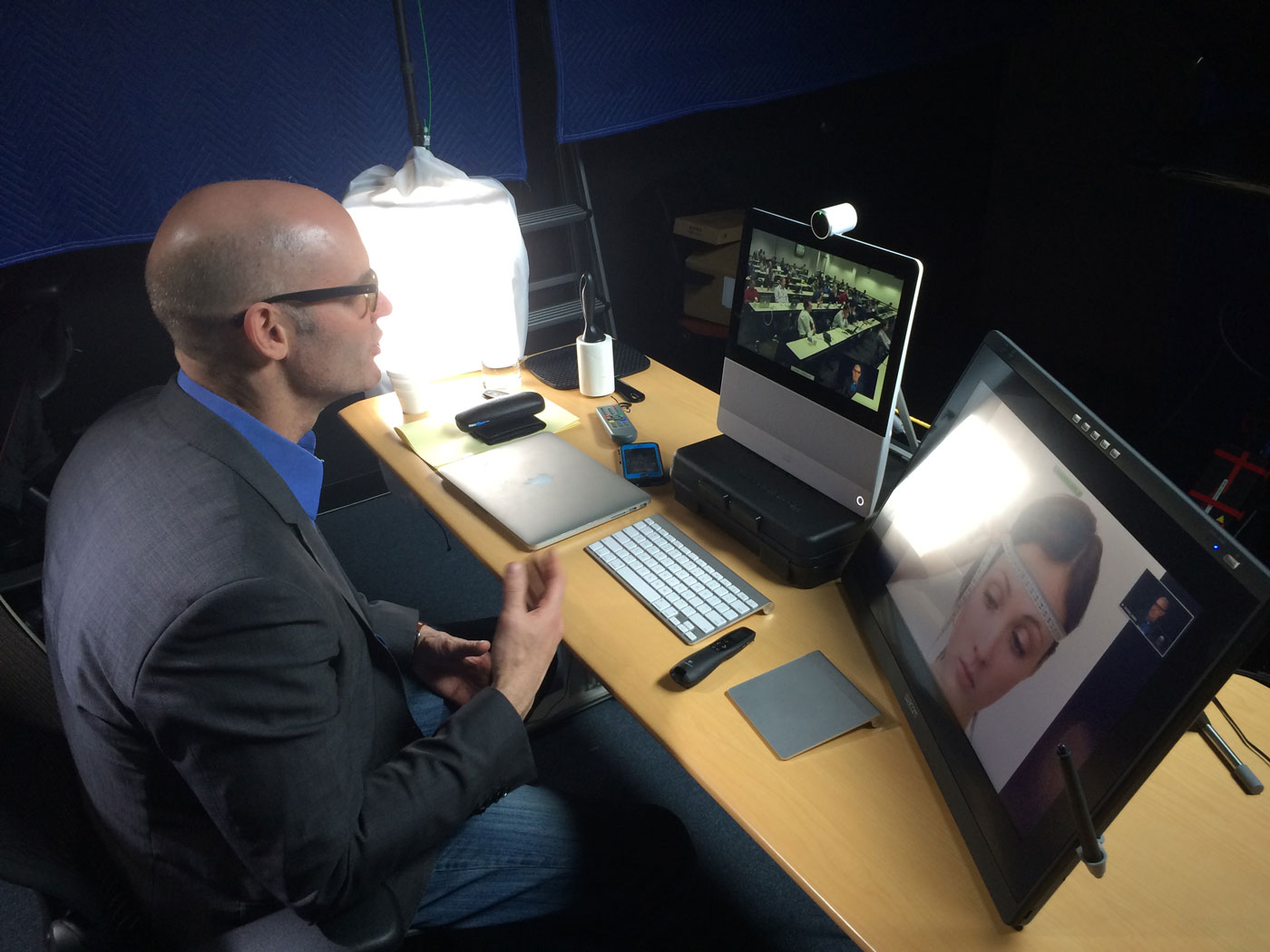
From remotely working with faculty to set up a home studio recording to collaborating with teammates virtually, Media Designers at the Center for Academic Innovation are finding new ways to solve problems
Parnia Mazhar, Communications Fellow
Media designers at the Center for Academic Innovation need to understand both the art and the science of developing online content. That is even more true as the coronavirus pandemic has caused them to collaborate in new ways and solve problems like never before.
Media designers develop compelling content in support of online and advancing residential educational experiences. They take on creating, filming, producing, and editing online content, tasks that became even more challenging after the pandemic struck. Instead of having their controlled black box studios with high-quality equipment, AI’s media designers now develop highly sought-after course content from their homes with minimal equipment.
While the shift has been a challenge, the media designers say it is more evident than ever how vital and effective online learning is in ending educational privilege across the world. If they can produce course content in these conditions, they believe there is no excuse for education to be inaccessible to all those seeking it.
The media design team, which includes designers Elly Daftuar, Jeff Butler, Matt Firsten, and Matt Lima, who were interviewed for this story, is responsible for producing the media content for all open learning initiatives and online and hybrid programs for the center. They collaborate with U-M faculty to create Teach-Outs, massive open online courses (MOOCs), content for online degrees, and short-form content, among other initiatives.
Before the COVID-19 pandemic, the team operated in a studio in Ann Arbor and were surrounded by teammates, equipped with various lighting configurations, set designs, and high-quality technology. Now, each media designer works from home. Instead of filming content and preparing the sets, they now guide faculty members on how to do it themselves without using professional video equipment.
Ensuring High-Quality Educational Content Shines

“Our studios are controlled environments, and so for more standard lecture content, everything is really set up to the point where it’s easy to replicate certain standards across our entire portfolio,” Daftuar said. “That’s a lot more challenging to do now that we’re relying purely on people’s homes as being the backdrop for their shots. So, now that we’re working remotely, we have to find new ways to be inventive about recording shoots.”
Though quality is more varied because of remote production, Daftuar said what matters most is ensuring the educational material’s quality remained top-notch.
“You know, there are some parts of quality that suffer right now,” Daftuar said. “But as long as a voice is always audible, and basically you can see a person or watch their slide deck and be able to read that or to hear them, if that’s sufficient for learning, then we’ll take it for now. Of course, we like to go above and beyond that, but as long as it doesn’t negatively impact the learner, we can run with it.”

While the shift to remote production has been challenging for the media designers, the group remains successful thanks to teamwork and collaboration. One instance of teamwork occurred when at the start of quarantine, Lima was working on one of the first projects that was going to be filmed remotely – the “Thrive in Trying Times Teach-Out.” He was able to learn and guide the other media designers after gaining this new experience.
“We had a great response from people in terms of them really liking how that course looked,” Butler said. “And that was because Lima did the legwork, found the extra information, and then he passed it along to us. We’ve always kind of found things out and shared it with each other, but in this case, it became part of the practice.”
Collaboration is Key
The group continued their collaboration throughout the entire remote production process. Quarantine began right at the start of production for the online series “Good with Words: Writing and Editing.” Rather than being discouraged by the change, the team came together and sifted through the hours of existing footage.

“We as a team were able to get this together and done in a few weeks,” Butler said. “It was a really cool team effort to see something like that come together, especially because it happened to be a little bit more intensive than something we typically would do. And we’ve had some really nice feedback in regards to that course.”
The team also credited team members, including Tim O’Brien, Technical Innovation and Platforms Lead for the center, and the remainder of the media technology team for pushing them and providing the needed support to continue producing content. They described how O’Brien would go into the office and test out different equipment for the MDs and how he was always adaptable to new situations that came up.
“Tim kills it,” Butler said. “He’s always looking for the best way to do something, and that keeps you striving to get better and better quality instead of settling for what we have. It’s nice to have that resource.”
Along with supporting fellow teammates, the media designers have also developed closer and more collaborative relationships with the faculty members who teach and create the educational content for the online learning initiatives.
In some cases, the media design team was in the middle of shooting when the pandemic forced a shift in process. To maintain the quality of the original content as much as possible for the remainder of the course, media designers would send out higher quality equipment to faculty to use for their filming. The media designers would coach the faculty over video conferencing on the proper use of the equipment and prepare their sets (typically, turning a person’s home into an attractive filming location) to develop the most high-quality content as possible.
“We always have a really close relationship with faculty,” Daftuar said. “But I think it’s heightened by that idea that we’re struggling through this thing together. And I think in that way, they feel maybe even a little bit more invested in making the content as well.”
Keeping a Connection Between Learners and Faculty
The media designers have also worked with faculty to ensure that communication between them and learners is not interrupted during remote learning. For instance, office hours enable learners to ask questions and have discussions with the faculty about course material. Before quarantine, half of the office hours were in person. Media designers like Firsten have worked hard to shift them virtually to ensure learners get this much-needed time with the professors.

“Office hours have been a major shift, because we have to remember that even though things have changed, we still have students to support,” Firsten said. “And we need to make sure that we are setting up the time for students to communicate with the faculty and ask questions during the duration they’re taking classes online.”
The team said shifting to remote production has presented challenges, but the team keeps producing the best quality content they can on behalf of learners. Their passion for making education accessible to as many people possible drives them to work at their best each and every day.
“What we’re doing is for the public and for students,” Firsten said. “Students are the most important thing at the end of the day, and I think that is a shared value that we all have.”
When Lima was a student, he experienced the value of online learning firsthand. He used online education to fill the gaps he felt were lacking from his educational experience in college.
“For me, I didn’t really go to a college that I particularly wanted to go to, it was just nearby and affordable,” Lima said. “But all the stuff that I wanted to learn was always accessible to me online. So I have a nice place in my heart of online learning because it can bridge that gap if you live in a place that just doesn’t have the things that are really inspiring you.”
Ultimately, this experience of producing online learning content remotely has shown the team that online learning is essential, especially in reducing the barrier to educational access. If they could create content from their homes with minimal equipment, there is no reason to stop developing online learning initiatives worldwide.
“I think this experience has shown us that there’s no excuse anymore that content can’t be created for educational purposes and that it can’t be accessible for people who seek it out,” Butler said. “I just don’t think there’s an excuse to hold people back from getting a good education anymore. What’s been proven in this quarantine more than anything else is that if we can create content from home with other people who are also at home, there’s no reason we can’t create content for a whole slew of courses.”


